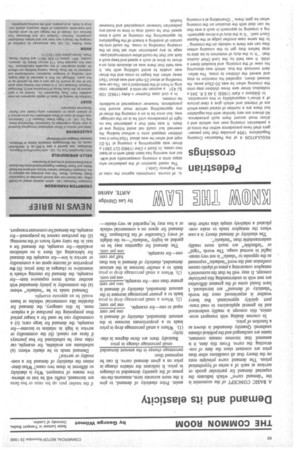MOW 71IE Lq
Page 68

If you've noticed an error in this article please click here to report it so we can fix it.
by Les Oldridge AIRTE, AMIMI
Pedestrian crossings
REGULATION 4 of the Pedestrian Crossing Regulations 1954 provides that foot passengers shall have precedence within the limits of a pedestrian crossing over any vehicle and a driver must accord them such precedence. All drivers are very familiar with this regulation but there are a number of stated cases which are of interest and which give a clear picture of a driver's responsibility in this connection.
In Gibbons v Kahl (1955) 3 All ER. 345a trolleybus driver saw three children step onto the crossing when he was 20-25yd away. He slowed down, signalled his intention to stop and waved the children to cross. The defendant overtook the bus, which was obscuring his view of the crossing, and knocked down a child. It was held by the Lord Chief Justice that: -It is the duty of motorists to be able to stop before they get to the crossing unless they can see there is nobody on the crossing."' In the same case another judge at the Appeal Court said: "It is the duty of a driver approaching a crossing to approach in such a way that he can deal with the situation on the crossing when he gets there." (Overtaking at a crossing
is, of course, completely against the rules of the Highway Code.)
The vexed question of the pedestrian who steps onto a crossing unexpectedly and without any warning has been dealt with in at least two cases. In Scott v Clint (1960) CLY 2801 a driver was approaching a crossing at 15-20 mph and when he was about lOyd from it two children stepped onto it without looking. He swerved but could not avoid hitting one of them. It was held that a pedestrian has no right of precedence until he is on the carriageway, but once he is on a crossing the driver of any approaching vehicle must accord him precedence, however unexpected or suddenly he crosses.
In a civil case Korimor v Adey (1962) 106 SJ 431 a woman ran onto a pedestrian crossing in front of the defendant's car. The car was travelling at about 25 mph and was about 15yd away when she began to cross and the driver was unable to avoid colliding with her. It was held that there was an absolute duty on a driver to drive at such a speed and keep such a look out that he could allow uninterrupted passage to any pedestrian who set foot on the crossing intending to cross. He could only be certain of avoiding a breach of the Regulations by approaching the crossing at such a slow speed that he could stop in time to avoid any pedestrian however unexpected and however foolish.




















































































































